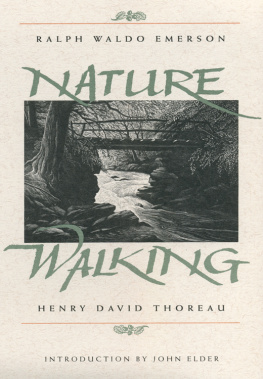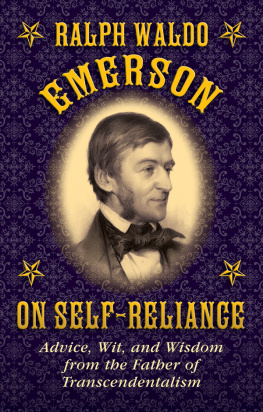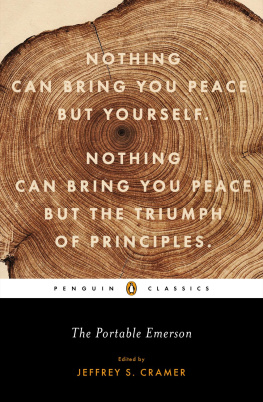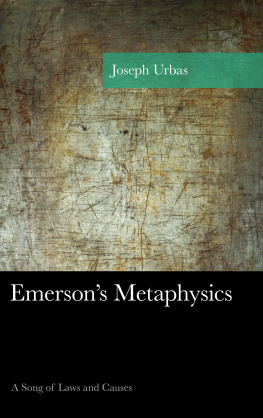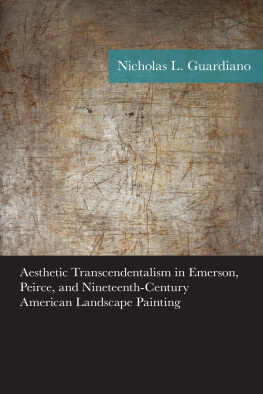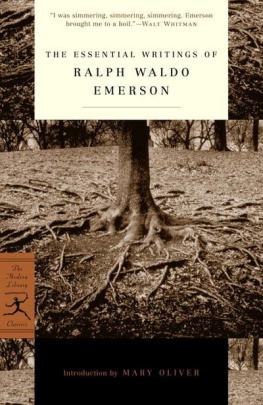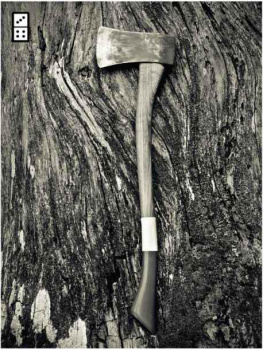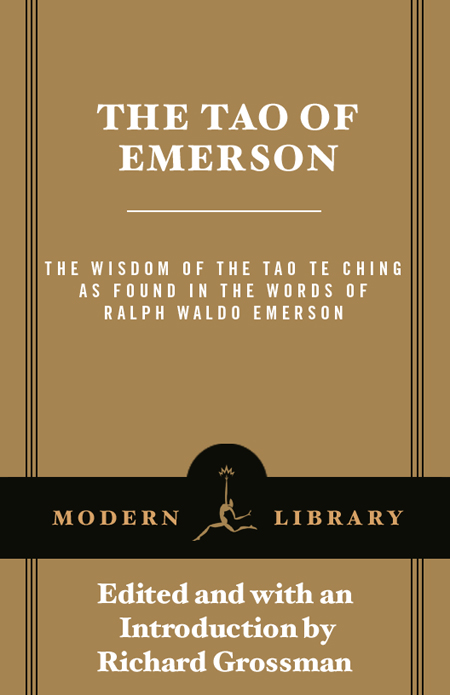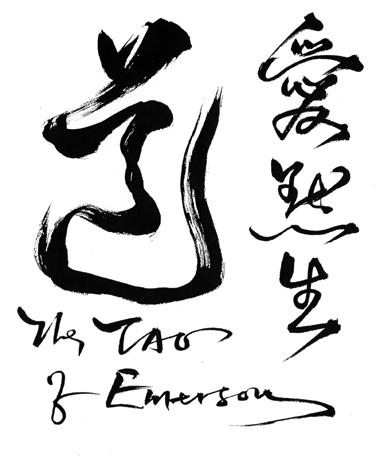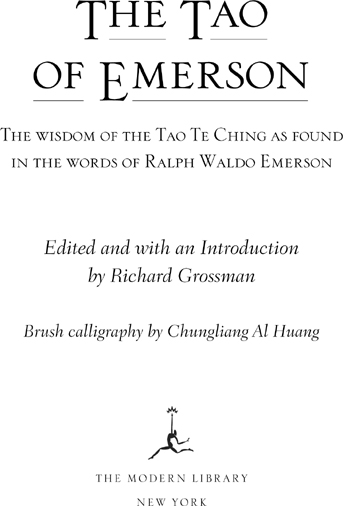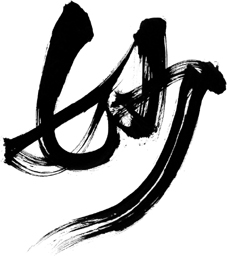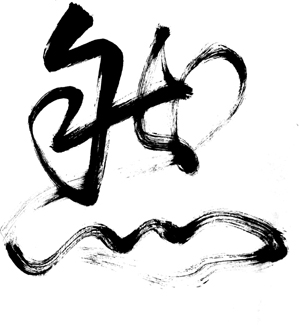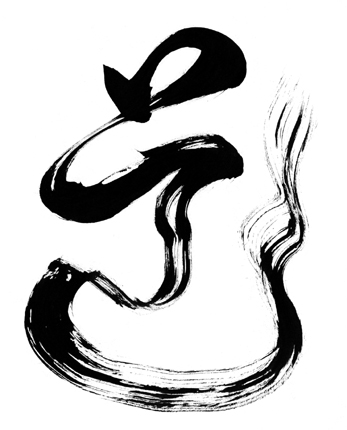All philosophy, of East and West, has the same centripetence.
A N OTE TO THE R EADER
This is one book, but within it are two manuscripts. The first, printed in italics on the left-hand (verso) pages, is based on the classical 1891 rendition of the eighty-one verses of the sacred Chinese text known as the Tao Te Ching, credited to a sage called Lao Tse and translated by the British Sinologist James Legge. On the right-hand (recto) pages is the second manuscript (in roman type), the same eighty-one verses of the Tao Te Ching, interpreted in words culled and organized by me from the writings of Ralph Waldo Emerson, the great nineteenth-century American philosopher and poet.
The inspiration for creating these parallel texts comes from the epigraph to this bookall philosophy, of East and West, has the same centripetencean observation recorded by Emerson in his essay on Plato when he was thirty-three years old, and already on the road to becoming Americas Founding Thinker. Centripetence, of course, refers to the tendency of energy to move or progress toward the center, to the essence of things. As Emerson later wrote, the hero is he who is immovably centered, and as Lao Tse put it, your inner being guard, and keep it freeboth men standing for what Emerson would later call the infinitude of the human soul. This veneration of both the depths and heights of the human soul blossoms in their writings into a credo for the conduct of life that elevates quietude, self-awareness, humility, and reverence for the natural world to such a level that it has captivated and inspired generations of men and women. The values contained within the words these sages wrote, no matter how cryptic or mystical they may seem in some instances, have given rise to a kind of spiritual anthropology, focused first on a site in ancient China housing a relic document over 2,500 years old, and second on a body of work created by a poet/philosopher in the quite early days of a new and animated country in the Western world. Each set of writings has captivated and inspired seekers to revisit them and probe their wisdom in search of a guiding personal truth.
This book is an effort to bring together these two kindred works. Using fragments of Emersons writings ranging in length from a phrase to an entire passage, I have tried to construct new poetic interpretations of Lao Tses words. It is not the intent of this rendition of the Tao Te Ching through the prose and poetry of Ralph Waldo Emerson to create an amusing word game by plundering the works of Emerson with a pair of scissors. Any great writers words can, by such manipulation, be made to reproduce the work of any other writer.
In this instance, the process by which Emersons writings are shown as parallel to the verses of the Tao Te Ching is one in which the shared sense and spirit and philosophy of the two men is displayed. To do this I spent a great deal of time immersed alternately in the work of the two authors, and recollecting the comparable thoughts I discovered in each. For instance, in Chapter 2 of the Tao Te Ching, which is intended to lay out the Taoist notions of complementarity (the yin/yang principle), a close student of Emerson thinks immediately of Emersons essay Compensation, devoted at least in part to the same idea: the universe is characterized by the sway between nonantagonistic, but opposite forces, as: spirit, matter; man, woman; odd, even; motion, rest. Thus, Chapter 2 in my translation employs five sentences taken from the Compensation essay. But there is a deeper connection to be seen when the dedicated reader of Emerson recalls that he also explored this theme in other places: in his poem Each and All, for instance, and in his address The Method of Nature as well as in his essay Spiritual Laws. Thus, one or more sentences from those sources become the Emersonian version of the sacred Taoist text. Conversely, in my daily rereading of Emerson, I highlighted any phrase that for me had the ring of the Taoist master. In this latter process, for example, as I read the phrase, I am a weed by the wall in Emersons essay Circles, I heard immediately the reverberation of the self-deprecating tone of Lao Tse in Chapter 20, I alone seem listless and still
The focus of this endeavor, then, is not so much on Lao Tses and Emersons similarities of verbal expression as it is on the wonderful ways in which philosophical ideas appear and reappear throughout history and across cultures, and are enriched in each new incarnation.
C ONTENTS
L IST OF I LLUSTRATIONS
I NTRODUCTION
Over 120 translations of the Tao Te Ching have been published in English since 1891. It has lured a variety of Sinologists, poets, philosophers, scientists, and scholars to try again and again to plumb its cryptic, provocative text for deeper meanings and for nuances that might make the wisdom of Lao Tse either more accessible, more modern, or more personally relevant to the Western reader. Some have wished to make the poetry more pronounced; others have wanted to make the translation more precisely like the original Mandarin language; still others have tried to make the Tao Te Ching a more religious document, a kind of Taoist Bible.
Almost all the translators of the Tao Te Ching, including James Legge, whose translation is used in this book, called their work interpretations, acknowledging the enduring fact that it is impossible for the language of one tradition to provide exact verbal equivalents for all the creative ideas of another tradition. In The Tao of Emerson I have not had to be concerned with verbal equivalency because I have concentrated not so much on the words of the Tao Te Ching, but rather on the ideas embedded in them. I have taken this approach because, after many years of reading and studying both the ideas of Lao Tse, the rural mystic, and the works of the Sage of Concord, I have become convinced that in a mysterious but remarkable way, Ralph Waldo Emerson, a self-defrocked American minister of the nineteenth century, evolved a personal worldview and philosophical stance so parallel to the Tao Te Ching that his own oeuvre of over forty volumes of poetry, lectures, addresses, personal journals, and notebooks contains the essence of the sacred ancient text.
These two men, separated in history by almost 2,500 years, one a citizen of the worlds oldest empire and the other of one of its youngest republics, were sages whose messages were remarkably alike: live the simple, tranquil life; trust your intuition; find and revere the spiritual grace in the natural world; act without self-assertion; commit no violence against living things or persons; try to harmonize with the ebb and flow of nature and circumstancesand above all, assure that there is a place in the world for humility, yielding, gentleness, and serenity.


